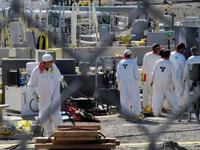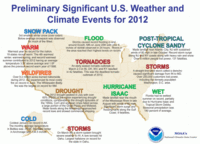-
Water security experts at U Arizona annual conference
How can Arizona secure a safe, sustainable water supply for its current and future residents? The University of Arizona Water Resources Research Center will take on this complex issue at its annual conference on 5 March.
-
-
Much less additional land available for biofuel production
Amid efforts to expand production of biofuels, scientists are reporting new estimates that downgrade the amount of additional land available for growing fuel crops by almost 80 percent.
-
-
Radioactive leaks at Washington’s Hanford nuclear reservation

Earlier this month, Washington Governor Jay Inslee announced that a radioactive waste tank at one of the nation’s most contaminated nuclear sites is leaking, bringing more bad news to Washington’s Hanford nuclear reservation. The 177 tanks at the plant, which hold millions of gallons of highly radioactive waste from plutonium production, are way past their intended 20-year life span.
-
-
Guam uses dead mice to fight snake invasion

Guam has declared war on brown tree snakes, believed to have been carried to Guam around the end of the Second World War. The snakes have become a serious problem, eradicating native bird populations on the island.
-
-
Weather extremes caused by giant waves trapped in the atmosphere
The world has suffered from severe regional weather extremes in recent years, such as the heat wave in the United States in 2011 or the one in Russia 2010, coinciding with the unprecedented Pakistan flood. Behind these devastating individual events there is a common physical cause, propose scientists in a new study. The study suggests that man-made climate change repeatedly disturbs the patterns of atmospheric flow around the globe’s Northern hemisphere through a subtle resonance mechanism.
-
-
Wind power’s contribution has been overestimated

People have often thought that there is no upper bound for wind power — that it is one of the most scalable power sources. After all, gusts and breezes do not seem likely to “run out” on a global scale in the way oil wells might run dry. Yet the latest research in mesoscale atmospheric modeling suggests that the generating capacity of large-scale wind farms has been overestimated.
-
-
Georgia wants to redraw its northern border to tap Tennessee River water
Lawmakers in Georgia are renewing efforts to claim Georgia’s right to tap into the Tennessee River’s water supply. The lawmakers hope to achieve this by raising questions about the exact demarcation of the border between the two states.
-
-
Russian fireball largest ever detected by nuke monitoring organization
Infrasound has been used as part of the Comprehensive Nuclear Test Ban Treaty Organization’s (CTBTO) monitoring tools to detect atomic blasts since April 2001 when the first station came online in Germany. Infrasonic waves from the meteor that broke up over Russia’s Ural Mountains last week were the largest ever recorded by the CTBTO’s International Monitoring System.
-
-
Climate change as a national security issue
In a new report, Harvard researcher is pointing toward a new reason to worry about the effects of climate change — national security. During the next decade, the report concludes, climate change could have wide-reaching effects on everything from food, water, and energy supplies to critical infrastructure and economic security. “The imminent increase in extreme events will affect water availability, energy use, food distribution, and critical infrastructure — all elements of both domestic and international security,” the report’s author says.
-
-
Earthquake catastrophes and fatalities to rise in 21st century
Predicted population increases in this century can be expected to translate into more people dying from earthquakes. There will be more individual earthquakes with very large death tolls as well as more people dying during earthquakes than ever before, according to a new study.
-
-
Water managers can now consult new U.S. water evaporation maps
The amount of water available for people and ecosystems is the amount of annual precipitation — that is, snow or rain — minus the amount of annual evapotranspiration. Evapotranspiration itself is the amount of water lost to the atmosphere from the ground surface. Scientists map the long-term U.S. evapotranspiration rates for the first time.
-
-
The sobering reality of water security
Agriculture is one of the world’s most insatiable consumers of water. Yet, it is facing growing competition for water from cities, industry, and recreation at a time when demand for food is rising, and water is expected to become increasingly scarce.
-
-
The costly wild-weather consequences of climate change

Throughout 2012, the United States was battered by severe weather events such as hurricanes and droughts that affected both pocketbooks and livelihoods. Research suggests that in the coming years, U.S. five-day forecasts will show greater numbers of extreme weather events, a trend linked to human-driven climate change.
-
-
Russia meteor a “once every 100 years” event

The meteor which disintegrated in the skies over Chelyabinsk, Russia, early Friday morning entered the atmosphere at about 40,000 mph (18 kilometers per second). The energy released by the impact was in the hundreds of kilotons.The meteor is the largest reported since 1908, when a meteor hit Tunguska, Siberia.
-
-
System to vaporize asteroids that threaten Earth

As an asteroid roughly half as large as a football field — and with energy equal to a large hydrogen bomb – flew by Earth on Friday, two California scientists unveiled their proposal for a system that could eliminate a threat of this size in an hour. The same system could destroy asteroids ten times larger than the one known as 2012 DA14 in about a year, with evaporation starting at a distance as far away as the Sun.
-
- All
- Regional
- Water
- Biometrics
- Borders/Immig
- Business
- Cybersecurity
- Detection
- Disasters
- Government
- Infrastructure
- International
- Public health
- Public Safety
- Communication interoperabillity
- Emergency services
- Emergency medical services
- Fire
- First response
- IEDs
- Law Enforcement
- Law Enforcement Technology
- Military technology
- Nonlethal weapons
- Nuclear weapons
- Personal protection equipment
- Police
- Notification /alert systems
- Situational awareness
- Weapons systems
- Sci-Tech
- Sector Reports
- Surveillance
- Transportation
Advertising & Marketing: advertise@newswirepubs.com
Editorial: editor@newswirepubs.com
General: info@newswirepubs.com
2010-2011 © News Wire Publications, LLC News Wire Publications, LLC
220 Old Country Road | Suite 200 | Mineola | New York | 11501
Permissions and Policies
Editorial: editor@newswirepubs.com
General: info@newswirepubs.com
2010-2011 © News Wire Publications, LLC News Wire Publications, LLC
220 Old Country Road | Suite 200 | Mineola | New York | 11501
Permissions and Policies
